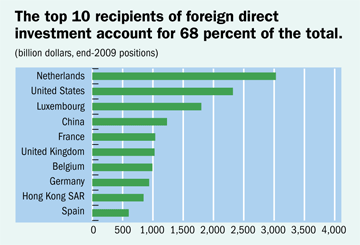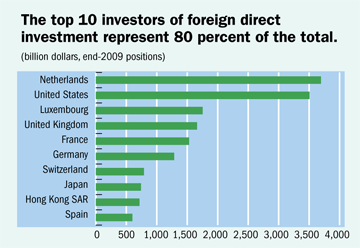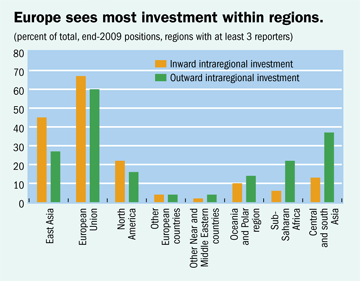Where Investment Goes
Finance & Development, September 2011, Vol. 48, No. 3
The Netherlands is the major conduit for foreign direct investment
THE NETHERLANDS was the No. 1 recipient of foreign direct investment (FDI) globally as of end-2009, but because most of the funds passed through on the way to other economies the Netherlands was also the top source of FDI, according to new data from the IMF᾽s Coordinated Direct Investment Survey (CDIS). The United States—the world’s largest economy—had the second-largest amount of inward and outward direct investment, followed by Luxembourg. China received the fourth-largest amount of direct investment, 45 percent of which was invested via Hong Kong SAR.

The Netherlands had a total of $3.0 trillion in inward direct investment positions and had invested $3.7 trillion in other economies as of end-2009. Luxembourg was No. 3 and like the Netherlands was largely an “in transit” destination. Both countries have special legislation that provides advantages to multinational corporations using these countries as pass-throughs.

Most of the inward and outward direct investment—about 80 percent at end-2009—was between advanced economies. All of the economies in the top-10 lists except China are advanced economies. This concentration of direct investment can be attributed to advanced economies’ generally larger markets, better-educated labor forces, greater profitability, and more developed financial markets.

Except for the European Union and east Asia, there was limited direct investment within regions. In the European Union, intraregional direct investment for both inward and outward investment levels was greater than 50 percent. Inward direct investment positions within east Asia were also significant at 45 percent. (Outward direct investment levels within east Asia are skewed downward because some large economies did not report investments abroad on the CDIS.)
What is foreign direct investment?
Foreign direct investment is investment by a resident in one economy in an enterprise that is resident in another economy in order to control or exert significant influence over the management of that enterprise. Such equity and debt investments are important for recipient countries because they provide financing and other resources, adding to economies’ growth prospects. Direct investment often includes technological transfer, market access, and other benefits to the recipient economy, and is usually long-term in nature.
About the database
The CDIS is the only worldwide survey of foreign direct investment positions. The database currently includes end-2009 inward positions reported by 84 economies (59 economies also reported outward positions) by the counterpart economy—that is, the economy from which the investment comes (inward) and into which the investment is sent (outward). The survey results can be found at http://cdis.imf.org


